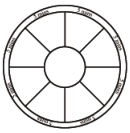阅读下面短文,从短文后的选项中选出可以填入空白处的最佳选项。选项中有两项为多余选项。
Recently, I carried out an investigation to discover what it was that prevented people from journalling. So, today, I want to introduce a very simple tool-The MicroMOVEment Wheel. It will help you pick up your journal even at times when you really don't feel like it.
She describes creating this method so she could use it as a creative planning tool for her writing projects and goals. While it was originally aimed at writers, you can use this technique to help you complete any project in a fun and creative way.
Here's how it works. Take a blank sheet of paper and draw a large circle, and then another smaller circle in the middle. In the centre circle, write down what you are inspired to achieve. Remember, journalling does not need to feel like a chore in your day. So come up with descriptions for your journalling that are inspiring and energising. These are what SARK refers to as the MicroMOVEments. Each MicroMOVEment is five minutes in length. So, in the case of journalling, that would represent a minimum of up to five minutes of journalling in one sitting, on any given day.
Let's say you're new to journalling. By setting aside five minutes out of your day, you could write one word in your notebook that sums up a feeling or an experience. The idea of the MicroMOVEment is to create easy steps to get your journal writing or writing projects moving. When you keep the steps small, it will become double and achievable.

A. Next, divide the rest of the circle into eight equal parts.
B. It is the brainchild of international bestselling writer SARK.
C. There are no hard-and-fast rules when it comes to journalling.
D. Where to start and not having enough time were amongst the top responses.
E. Daily tasks such as sweeping and washing are time-consuming and laborious.
F. Then, list any associated words, images or thoughts that are generated by the word.
G. The medicine with this approach is breaking your actions down into the tiniest steps.